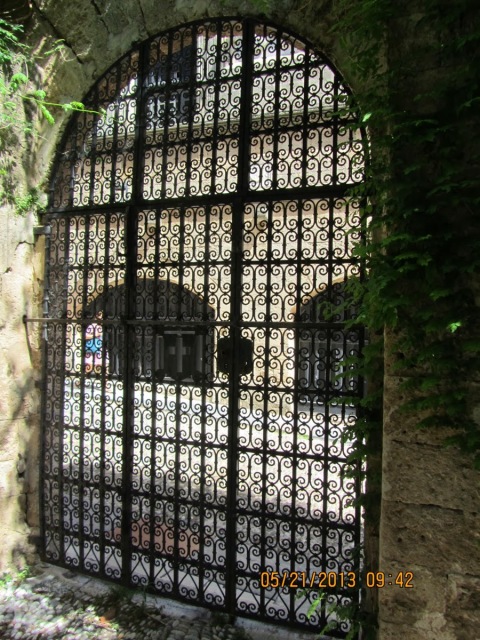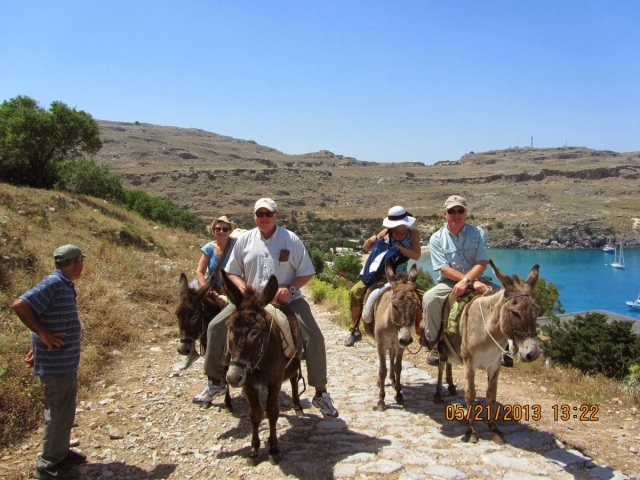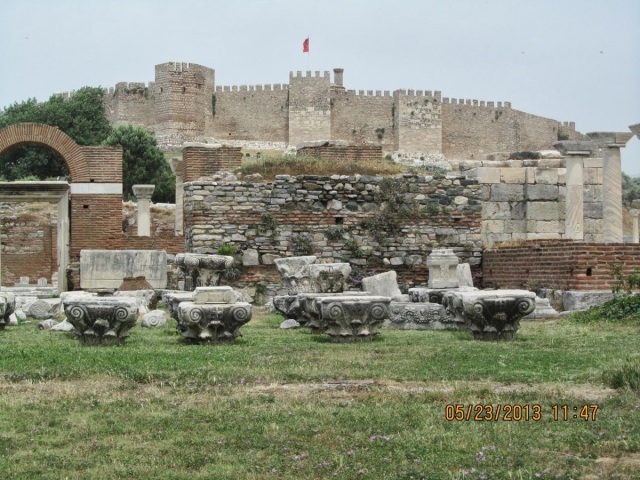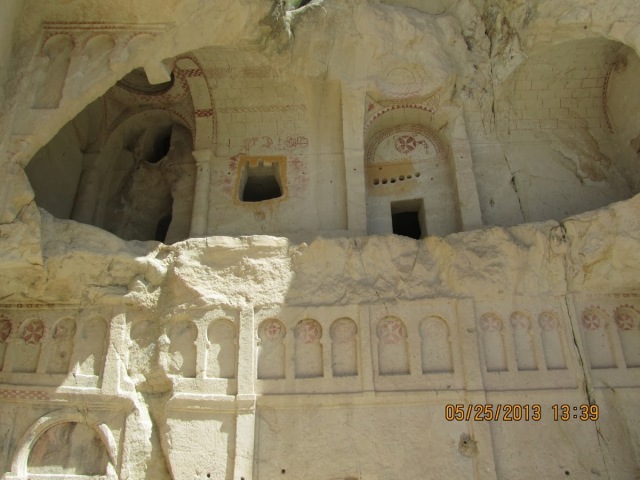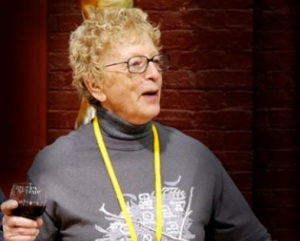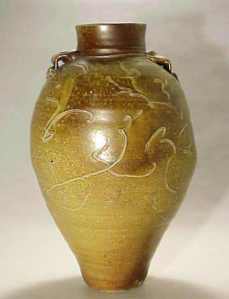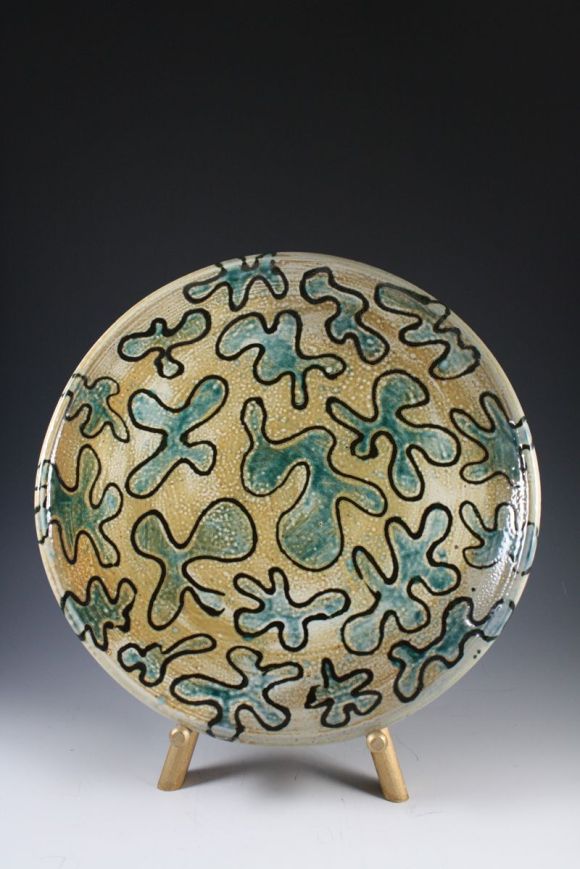Greece and Turkey 2013
2013 marked our 20th wedding anniversary, so it took little prompting for us to decide to celebrate with a trip abroad. We coaxed the Guschewskys into joining us, and after much thought and consideration (?) we decided Greece and Turkey, with a cruise through the Greek Islands, would be just the ticket. (We love how hard it is to convince Cathy and Chuck to dive in.) We booked a cruise on Wind Star’s Wind Spirit, a sailing vessel accommodating 148 passengers, and worked with Nancy Porthan at Noble Travel to coordinate the rest of the trip.
Tuesday, May 14, 2013
Connie and I drove to Denver and met Cathy and Chuck at the airport into which they flew, where they would leave their plane for inspection and repairs. We checked into the Marriott near the airport, had cocktails (of course) and then had dinner at Piatti’s in Cherry Creek. Our dear friend Chuck ordered a limo to take us to and from dinner that night, which set the tone for the entire trip. By this, I mean we were spoiled rotten.
Wednesday, May 15, 2013
Our flight didn’t leave until late afternoon, so I treated myself to a mani-pedi while the rest of our group did my shopping for me. Do I sound spoiled yet? We had lunch at Cherry Creek Grill, where we sat outside and enjoyed the beautiful weather. Then to the mall for a little last minute shopping before returning to the Marriott to gather our luggage and hop onto the shuttle to the airport.
It was a looooong flight on Lufthansa (we felt it was more cramped than British Airways) with no personal vents or TV screens to make the time go faster. The drinks, however, were free–that helped!
After a short stop in Frankfurt, we boarded a second plane for Athens. It was on this flight that a medical emergency developed, and the crew asked for assistance from medical professionals. Connie volunteered and helped an older Greek man, now living in Corpus Christi, TX, who was having an apparent heart attack. The man had a history of heart disease and had nitro with him, thankfully. Connie monitored his condition and we were given emergency clearance for landing, where the afflicted man was taken off the back of the plane and into an awaiting ambulance. The crew were fabulous during the crisis, and afterward they asked us to stay behind so our female Captain could thank Connie.
We arrived in Athens on . . .
Thursday, May 16, 2013
at about 5:30 pm. We were met by our transfer guide, Athena Makraki, in a Mercedes Van large enough for a dozen people. Athena briefed us on the lay of the land, and made sure we were safely checked in to the Hotel Bretagne. The hotel is lovely, truly world class.
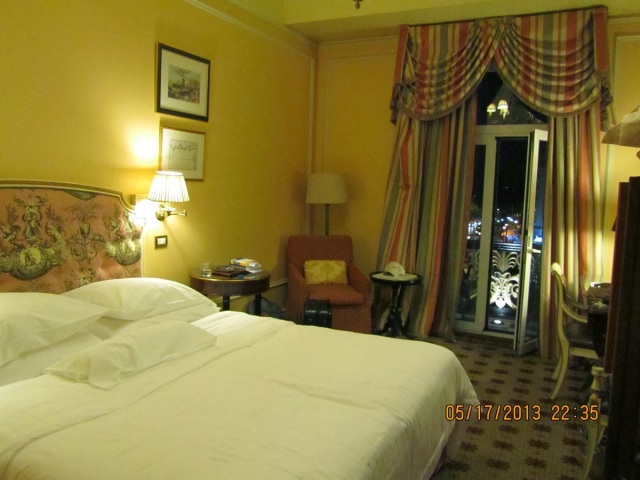 |
| Our Room at Hotel Bretagne |
 |
| The Balcony off our room at Hotel Bretagne |
From our hotel room balconeys we had views of Syntagma (Constitution) Square, and the Presidential Palace/Parliament building. From the balconies, we could witness the Changing of the Guard at the Parliament, by the Evzones, the soldiers of the National Traditional Guard, wearing their crazy cheerleader costumes and performing their strange and awkward-looking march.
 |
| Evzone, Soldier of the National Traditional Guard during Changing of the Guard Ceremony |
On that first night we had cocktails in the downstairs hotel lounge and then took a cab to dinner at Psarris, a restaurant recommended by both the concierge and Athena. The restaurant is located in the historic neighborhood of Plaka, near our hotel. We sat outside under their awnings and were treated to every imaginable variety of Greek cuisine. Our wait staff was wonderful, actually moving us to a safer location on the deck when rain threatened.
 |
| Psarris Restaurant, Plaka Athens |
We returned to the hotel, and proceeded to their rooftop restaurant where we were treated to our first view of the Acropolis, with the Parthenon and other temples lit up in the night like Disneyland!
 |
| The Acropolis at Night, taken from Hotel Bretagne |
We enjoyed the view with a cocktail, then made our way to our rooms to try and beat the jet lag.
Friday, May 17, 2013
We feasted on a sumptuous buffet breakfast in the rooftop restaurant at Hotel Bretagne, then met Mariza Anifandi, our guide for the day, in the hotel lobby.
 |
| Athens Guide, Mariza Anifandi |
Mariza was a school teacher as well as a tour guide, doling out candy rewards when we remembered our lessons well!
Mariza first took us to the Acropolis, where we hiked up to the grand entrance, the Propylaia, and visited the Parthenon itself, along with the Temple of Nike (dedicated to Goddess Athena) and the Erechtheion, with it’s female caryatids acting as columns. We also had grand view of the city below, including the Roman arches at Theater of Herodes Atticus. This theater is still in use today for various concerts and events. The Roman arches are quite prominent. We learned that most Roman era architecture there involved mortar between the stones, whereas the Greek architecture was dry stacked.
 |
| Theater of Herodes Atticus |
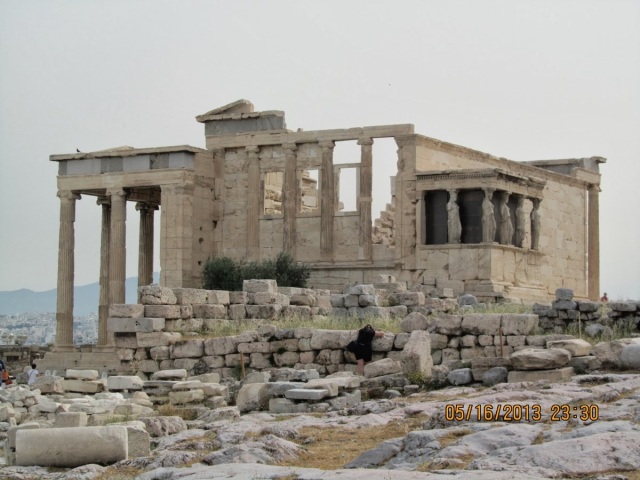 |
| The Erechtheion |
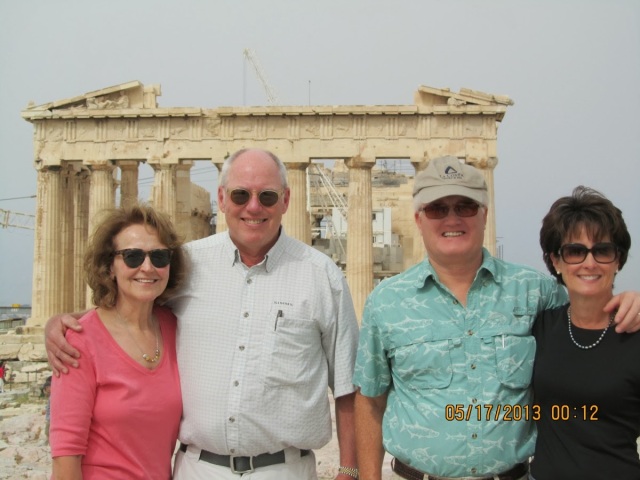 |
| Deb, Connie, Chuck and Cathy in front of The Parthenon |
 |
| A view of ruins and the City of Athens from the Acropolis |
 |
| The Erechtheion |
The Parthenon, itself, was struck by a Venetian cannon ball in 1687, (while the Parthenon was being used as an arsenal storage facility), suffering much of the damage we see today. Archeologists are still in the process of numbering each piece and attempting to puzzle together the Parthenon of the past.
From the Acropolis, we went to the Acropolis Museum, which housed artifacts from –you guessed it–the Acropolis. When the site was excavated for this new museum, parts of the ancient city were found, so they built the museum on stilts, using glass floors in many areas so you can actually see the ruins below and the work being done there. The highlight of the museum was the third floor, where a life-size scale model of the Parthenon can be found, with bits and pieces of its metopes and friezes in place were they were on the original structure. Sadly, there is a huge blank spot were sticky-fingered Lord Elgin paid the conquerers of Athens to take the renowned Elgin Marbles to England, where they reside in the British Museum. The Greeks are attempting to get the pieces returned, but none are optimistic of their chances.
 |
| Excavation beneath The Acropolis Museum |
 |
| An original Caryatid from the Erechtheion |
 |
| A sculpture from The Parthenon |
Next we traversed through the streets of Plaka, the old city. Mariza pointed out various sites to us, including the Tower of the Winds, which was an ancient octagonal Pentelic marble clocktower on the agora in Athens that functioned as a horologion or “timepiece”. The structure features a combination of sundials, a water clock, and a wind vane.[1] It was supposedly built by Andronicus of Cyrrhus around 50 BC, but according to other sources, might have been constructed in the 2nd century BC before the rest of the forum.
 |
| Tower of the Winds, Athens |
 |
| Street in Plaka area of Athens |
 |
| Strawberries in Plaka Market |
 |
| Church of Panaghia Kapnikarea, Athens, Greece (Plaka, old town area) |
We also saw ruins of the Roman Forum/Agora,
 |
| Roman Forum/Agora |
and Hadrian’s Library
Emperor Hadrian, who ruled the Roman Empire from 117 to 138 AD was an ardent admirer of Greek culture and regularly visited Athens. Hadrian wanted to make Athens the cultural capital of the Roman Empire, and during his visits he initiated several building projects, including the construction of a large library.
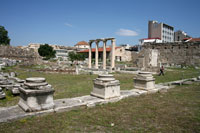 |
| Hadrian’s Library Complex |
The library was built between 125 and 132 AD on a rectangular plan. It wasn’t a library as we known today, but more a cultural complex, with lecture halls, a transcription room, a library hall – known as the Bibliostasio – and possibly even a theater.
The complex – which measured about 120 meters long and 78 meters wide (400 x 260ft) – was built around a large rectangular inner garden with a pond. The garden was adorned with large marble statues of Athena and Hadrian. The floors of the halls were decorated with mosaic marble tiles. Papyrus rolls were stored in forty niches in the library, which held an approximate 16800 ‘books’.
As we walked, we saw probably the oldest church in Athens, The Greek Orthodox Church of Panaghia Kapnikarea. It is estimated that the church was built some time in the 11th century, perhaps around 1050. As was common with the early Christian churches, this was built over an ancient Greek pagan temple dedicated to the worship of a goddess, possibly Athena or Demeter.
We next boarded our van and drove most of the way up Lykavittos Hill, the highest point in Athens, from where there were stunning views of the city below. Lycabettus appears in various legends. Popular stories suggest it was once the refuge of wolves, possibly the origin of its name which means “the one that is walked by wolves”. Mythologically, Lycabettus is credited to Athena, who created it when she dropped a mountain she had been carrying from Pallene for the construction of the Acropolis after the box holding Erichthonius was opened.
Next stop was the Modern Olympic Stadium, which was built for the first modern Olympic Games in 1896.
 |
| Modern Olympic Stadium, Athens |
Then it was back to the hotel where we watched the changing of the Guard at the Parliament/Presidential Palace. Pretty crazy antics by these guys with their cheerleader outfits (as Chuck called them), complete with pompoms on their shoes! Here’s a video link: Evzones, Soldiers of the National Traditional Guard.
After a little R&R, we met for dinner at the Rooftop Restaurant at Hotel Bretagne, where we enjoyed the view of the Acropolis once again. A few cocktails later, we retired to our rooms to re-pack for tomorrow’s sailing adventure.
 |
| Dinner on the rooftop of Hotel Bretagne |
Saturday, May 18
Everyone was a little tied up with money exchange, packing, etc. the next morning, so after breakfast at the Bretagne, I took off by myself to spend a couple of hours at the Archaeological Museum. In a brief two hours I was treated to some of the most famous works of ancient art in the world, many that I had studied in art history courses. Most notably the statue of Poseidon (or Zues), the bronze Horse and Jockey, and my favorite, the Cycladic figures.
 |
| Poseidon (or Zeus) |
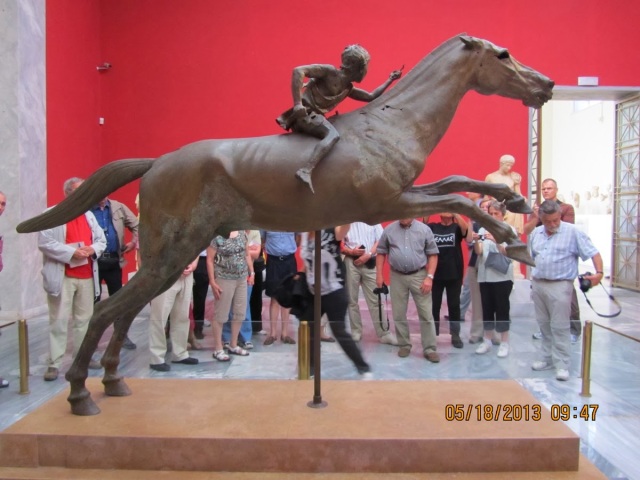 |
| Horse and Jockey |
 |
| Cycladic Figure |
After a bit of a tussle with a suspicious taxi driver (he didn’t want to take my Euro because one end was slightly torn), I arrived back at the hotel and we all were greeted by our private van for the trip to the pier to board the Wind Spirit.
We were greeted on board by the crew with Mimosas, so we knew we had to be in the right place! We signed up for unlimited laundry service and unlimited cocktails–both of which turned out to be essential!
Cathy and I immediately signed up for facials, which were completed just as the safety drill before departure was started. Our facials were done by Katerzina (Kate), who was from Wroclaw, Poland. Cathy and I separately had nice conversations with her about her home town as we had just visited there last year for Mike & Ania’s wedding. We had lunch on the ship in the Veranda, got settled in, and then met for cocktails on deck. We missed the orientation meeting, but got the chance to see some dolphins playing off the back of the ship–good call. And of course Cathy took the helm as we set sail, making sure we didn’t run aground!
Meanwhile, we got to know our bar stewards, Chris, Erwin and ?, along with Kada at lunch. Dinner that evening was in The Restaurant on the Wind Spirit. The dinner was barely underway when I heard Connie ask Chuck, “Can you speak?” Chuck, with a panicked look on his face, frantically shook his head, NO. Connie jumped up and grabbed Chuck, successfully administering the Heimlich maneuver. Tragedy averted! Connie had never done this before, but thankfully he noticed Chuck was in distress and managed to dislodge whatever was blocking Chuck’s airway. Other than a little throat discomfort afterwards, Chuck was fine. The wait staff saw what happened and offered to call the ship’s doctor, but at that point, there was no need. Dinner was aborted and we retired to the bar where we licked our wounds and thanked our lucky stars.
Sunday, May 19
Sunday morning we awoke and found ourselves in the port at the Island of Mykonos, Greece. We immediately took a shuttle boat for the 1/2 hour ride to the Island of Delos.
Delos was inhabited in archaic times (2500 BC), but as the birthplace of Artemis and the sun god, Apollo, her twin, the island was declared sanctified ground and all inhabitants were exiled in 426 BC. Even the graves were exhumed and removed. This is the place where the Delian League housed their money until Pericles declared the island was vulnerable to attack. He moved the funds to Athens, thus justifying the erection of the Parthenon for its safe-keeping. This ultimately ended in war when the contributors saw that their “protection fund” from the Persians was being used to glorify Athens.
The island was incredible, with ruins everywhere. One got the feeling that they were the first to discover it. Highlights were the many mosaic floor remains, the Temple of Isis, the Temple of Dionysus, The Dolphin House, and of course the hike to the top of the Acropolis of Delos. We also visited the museum there, where some of the relics were housed for protection from the elements.
 |
| Deb and Cathy with Statue of Isis |
 |
| Atop the Acropolis of Delos with Connie and Chuck |
 |
| View from the Acropolis of Delos |
 |
| Mosaic Floor in House of Dolphins |
 |
| Mosaic Floor in Temple of Dionysus |
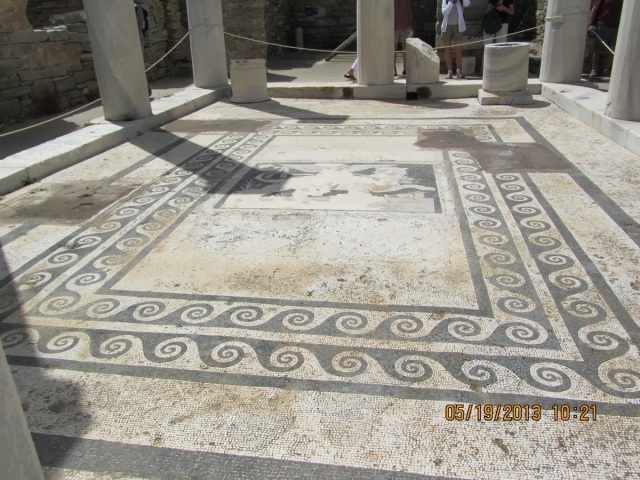 |
| Mosaic Floor in Temple of Dionysus |
Upon returning to Mykonos City, we strolled through the narrow, winding streets, taking in the windmills for grinding grain and the pelicans. Connie fell in love with a local cat. We were eventually lured into a restaurant for lunch, Katerina’s. The owner had spent some time in the US, and was very persuasive, promising us wonderful views. Unfortunately the view tables were outside and all occupied, but we had a good time with him and his waitress, nevertheless. There was an Asian couple taking their time on the view deck taking glamour shots of each other. Boo. After much persuasion, the waitress finally gave up the recipe for grilled feta. (Feta, Olive Oil, Tomatoes, Oregano, Red Pepper, Onion). Delicious!
 |
| Windmills on Mykonos |
 |
| Narrow Streets of Mykonos |
We were told we would get lost on these winding streets, and of course, we did!
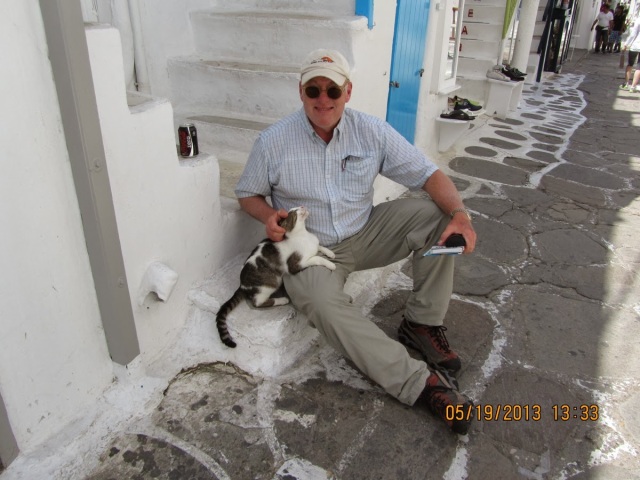 |
| Connie with his new kitty friend |
 |
| Deb and her new pelican friend |
After lunch we checked out the various shops and inquired as to whether there were any mosaic artists represented in any of the shops. We were directed to a small shop which we found after much meandering, only to find it closed. We headed back to the waterfront where we had drinks in an open-air restaurant where we could see our Wind Spirit in the distance. We then boarded the tender back to the ship. Chris and Erwin fixed us up and we had a nice discussion of our day on Mykonos. Connie and I decided we would like to go back and see if the Mosaic Artist was in her shop. She was not, but the flower shop next to her was open and the owner had a key to the Mosaic Shop. She let us look around, and called the artist to ask her to come and meet us.
While we were waiting, we popped across the pedestrian street (alley?) to a bar called “Bubbles”, where of course, I ordered a glass of “bubbly”. Connie ordered a drink, too, and we waited for the arrival of the mosaic artist. (Apparently Mykonos is the “Party Island”, and Bubbles gets quite crowded in the evening hours.) While waiting in the quaint outdoor seating area, Connie popped across the alley and bought a wreath from the flower vendor for Cathy to have in their room on the ship.
 |
| Bubbles Gallery–The Art of Drinking |
 |
| Flower Vendor in Mykonos |
The artist arrived. Her name is Irene Syrionou, and she is an art teacher in Mykonos, extremely nice! We bought a fish mosaic from her, and as a gift she gave me a porcelain fish necklace that her boyfriend made. Not only that, she insisted on buying our drinks at Bubbles, where we had yet to settle our tab. We got the feeling the shop owners there are very close. Once we were back on board the Wind Spirit a package arrived for us. Irene had sent over a stand for our mosaic on the last tender. That is service!
We returned to the ship and set sail to Vangelis, “Conquest of Paradise”, the same song that is played every time the ship sets sail. That evening we had a reservation to eat on deck. A very nice meal of grilled steak, etc.
Monday, May 20
We awoke as we were anchoring near the Island of Santorini, Greece. Santorini is a crescent-shaped island–the remnants of an inactive volcano. Many artifacts remain from before the eruption, but for the most part the island’s 6000 residents have rebuilt over the ruins. In fact, the mid section of the island did not exist prior to the volcano, but was filled in with the lava flow. In 1956, the island was struck by an earthquake, the capitol of Phira (Thera) suffering the worst of it.
After breakfast at the Veranda on board, we boarded the tender to the island. The town of Phira (Thera) is located atop a cliff. To get there, we had to choose between a donkey ride up a winding slope, or ride a tram. We wisely chose the tram, thus partially satisfying my funicular enthusiasm. Some of our hosts on the Wind Star traveled on the tender with us to the island. They were either walking or riding donkeys. We waved to them from the tram as they trudged up the hot, dusty, switchbacks to the top.
We quickly located a taxi, and started to make our way to the picturesque town of Oia, on the other side of the island. We were treated to the wildest taxi rides of our lives–literally. Our crazy driver, Phimeo, passed cars on death-defying curves and made abrupt stops to offer us “side trips” to locations where he thought we might want our pictures taken. We respectfully declined. It was with great relief that we arrived in Oia, where he offered to pick us up after our visit, as he claimed there were very few taxis to be had for the return trip. Once again, we respectfully declined.
We wound our way through the beautiful, narrow streets of Oia, with it’s sparkling white buildings and bright blue accents. We popped into many of the shops, Cathy and I making a few purchases, while Chuck and Connie entertained themselves watching the street vendors and purchasing “splatter toys” , i.e. eggs, tomatoes, for the grandkids. Connie ended up giving some of his to an unhappy little boy we encountered in a cafe where we stopped for a refreshing drink and break from the heat.
Here are a couple of images of Oia, including the hotel I plan to stay in, when I return to Santorini!
We walked to the pinnacle of the old fort there and took in the view, then meandered back to where we had left our life-threatening taxi driver, Phimeo, only to find him right where we had left him–along with about a dozen other taxis. Since his was the next taxi available, we were obligated to once again defy the odds and ride with him. On the ride, we were distracting ourselves by discussing lunch options when taxi driver chimed in that none of the places were discussing were either open or any good. But of course, he knew just the spot. He then drove us to a more remote part of the island, and dropped us off at a cafe, which–surprise–was owned by his cousin. It was called Geromanoles Cafe, which was an open-air affair. They served us some of their home-made wine, which was so awful, we poured most of it into empty beer bottles to hide the fact that we didn’t drink it! We were the only customers in the place, so it was a little hard to be discreet!
After finishing our meal, the proprietors offered to call a taxi for us. We were truly in the middle of nowhere, so getting a ride back was crucial. Of course they called Phimeo, their crazy taxi driver cousin, whom we assume had been taking a siesta somewhere while we dined. We closed our eyes and let him drive us back to the port of Phira (Thera). We returned to the Wind Spirit for a much-needed cocktail and a little relaxation time before dinner.
Tuesday, May 21
We awoke in the harbor of Rhodes, a Greek island once inhabited by the Knights Hospitallers who created an impressive fortress of stone. The stronghold was held by the Knights from 1309 until their defeat by Suleiman the Magnificent, Sultan of the Ottoman Empire, in 1522. Some of the architecture dates from both eras.
 |
| Suleiman’s Mosque |
 |
| Knights Hospitaller Medieval Fortress, Old Town, Rhodes, Greece |
We were on our own for touring, so we wandered into the Palace of the Grand Masters, where this staircase led to room after room of beautiful art work and floor mosaics. The Palace was destroyed in 1856, but rebuilt by the Italians.
 |
| Palace of the Grand Masters Staircase |
 |
| Floor Mosaic, Palace of the Grand Masters, Old Town, Rhodes, Greece |
After visiting the Palace of the Grand Masters, we walked down the Street of Knights in Old Town. This cobbled street with arched bridges is lined with the Inns of the Tongues and dates from the 14th Century. The Knights Hospitallers, Order of St. John of Jerusalem, were divided by nationality into groups known as Tongues. Each had their meeting place (inn), with their Coat of Arms, and these lined the Street of the Knights. The Inn of Provence and Chapelle Francaise are on the street’s north side, while on the south is Spain, one of the largest inns.
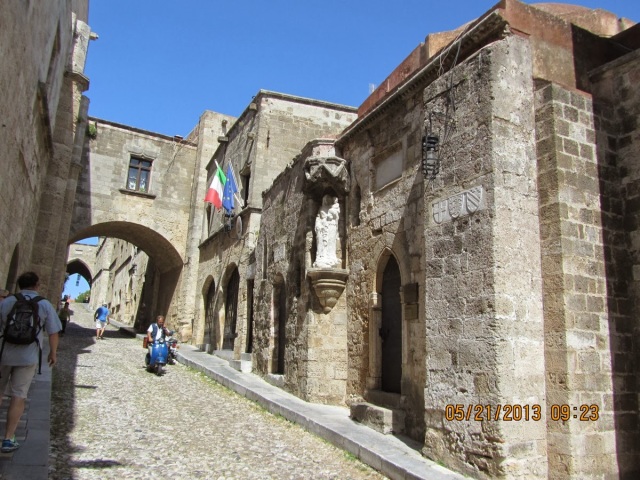 |
| Street of Knights, Old Town, Rhodes, Greece |
Our last stop in Old Town was to tour the Archaeological Museum, with its beautiful grounds. We were impressed by these stacks of stone balls, which we found out were ammunition for catapults!
The following photo of an iron gate was taken within the gardens of the Archaeological Museum, and opens onto the Street of Knights.
After our tour of Old Town, we rented a car. We decided to let Connie drive, although at some points he appeared to have been taking lessons from our crazy taxi driver in Santorini! Nonetheless, he managed to get us safely to the town of Lindos. We parked miles (at least it seemed like it) away and we walked into the quaint village. There we decided to hire donkeys to carry us to the top of the Acropolis of Lindos, thus satisfying that particular item on our bucket list!
Atop the Acropolis we had a beautiful view of the Aegean Sea, with St. Paul’s Beach (Agios Pavlos) at Lindos. It was an extremely warm day. We began to wish we had sought out the beach instead of the Acropolis! Very inviting!
 |
| St. Paul’s Beach, Lindos, Rhodes, Greece |
Atop the Acropolis was the Temple of Athena Lindia, dating to the Late 4th Century, BC. The remains of this temple are what replaced an earlier temple, destroyed by fire.
We descended the Acropolis of Lindos on foot, declining the opportunity for another donkey ride. We actually felt quite sorry for the poor beasts, who seemed to be in poor shape and struggling in the heat.
The Lindos cafe proprietors were very effective marketers, each vying for our lunchtime trade, but we found the rooftop restaurant we were looking for where our very handsome Albanian? waiter served and entertained us while we ate. We believe, but are not sure that we had goat. Libations were, of course, part of the fare. By this time I was becoming quite fond of the Greek white wine ( with the exception of the ill-fated Santorini Home-made stuff).
On our drive back to Old Town, we stopped at a local pottery, where the master potter was at work. Connie and I bought a few small plates to bring home.
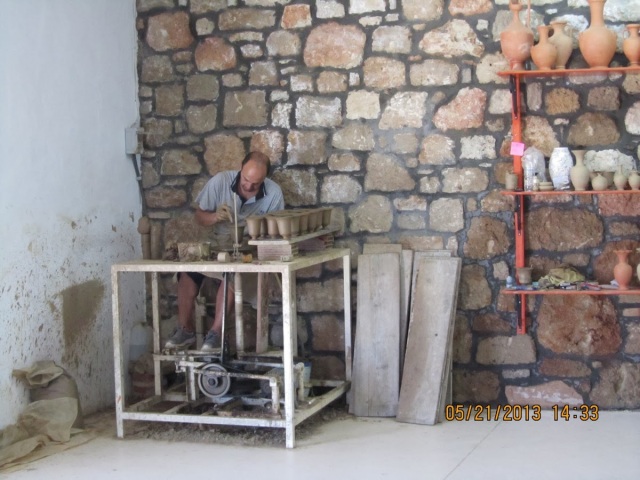 |
| Savas Ceramics near Lindos |
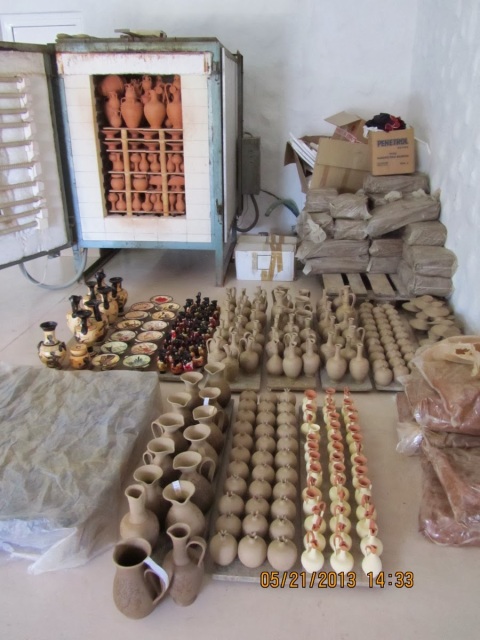 |
| Savas Ceramics Near Lindos |
Wish I could make my pots so uniformly beautiful!
That evening the Wind Star sailed late, so it was our only opportunity to have dinner off the ship. After returning to the Wind Star to freshen up, we returned to Old Town for dinner at Alexis Four Seasons. This turned out to be an incredibly expensive dinner ($600)–a $200 red snapper was involved. Probably the most expensive meal I’ve ever had–and enjoyed the least! There were plenty of cats around to snap up anything we happened to drop. Much to my dismay that happened to be the lobster.
 |
| Alexis Four Seasons Restaurant, Rhodes, Old Town, Greece
Yes, that’s an octopus hanging above the seafood cart!
|
 |
| $200 Red Snapper |
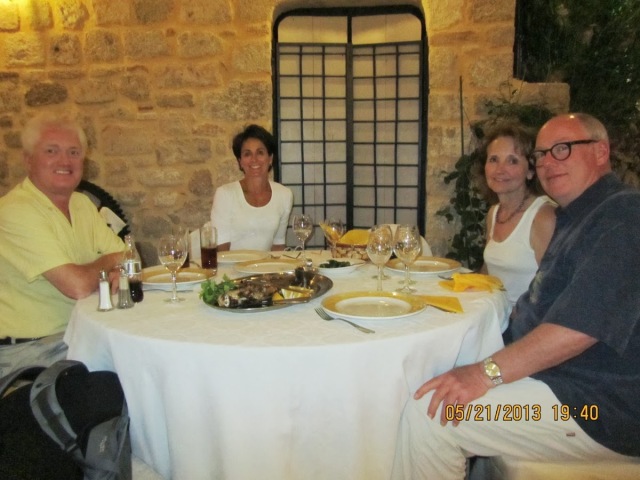 |
||||
| Enjoying Dinner at Alexis Four Seasons on Rhodes |
We returned to the ship and set sail for the short trip to Bodrum, our first stop in Turkey! There we were treated to the sight of our sister ship, the Wind Star!
Wednesday, May 22, 2013
Bodrum is the modern name of the ancient Dorian city of Halicarnassus, location of the famous Mausoleum built by Mausolus (375-53 B.C.) ruler of ancient Caria, who made the city his capital. The colossal Mausoleum was one of the Seven Wonders of the Ancient World. Mausolus intended it as his tomb. Work on the structure began in 355 B.C. and was completed by his widow, Artemisia, the only woman to rule Caria. It measured 134 ft. in height, with a podium, a colonnade of 36 columns and a pyramid, resplendently topped by a horse-drawn chariot statue. The tomb stood for about 1500 years but had fallen into ruin by 1402, when the Knights of St. John arrived and conveniently used many of the stones for constructing the Castle of St. Peter. The city walls, also built by Mausolus, were almost destroyed during Alexander the Great’s siege in the 4th century B.C., Herodotus, the father of written history, was born here in 484 B.C., as was Dionysius, the great rhetoric teacher of the 1st century B.C. Modern Bodrum was the first Turkish town to experience a tourist boom, its major sight being the 15th century Castle of St. Peter, a museum of nautical archeology which we were to tour.
We met our guide Ayshin, who led us on a tour of Bodrum Castle (St. Peter’s Castle). The castle has become a shipwreck museum, with beautiful grounds.
 |
||||||
| Ayshin with pottery relics from ancient schipwreck |
 |
| Connie and other relics at St. Peter’s Castle, Bodrum, Turkey |
 |
||
| Sultan, your underwear is showing!!! At St. Peter’s Castle, Bodrum, Turkey |
After leaving the castle, we made our way back to the docks where we located our Galet (boat), named “Mermaid”. Thanks to Chuck for finessing our way into a private boat tour in and around Bodrum in the Aegean Sea.
We were served a sumptuous lunch with many courses, and spent the afternoon relaxing aboard this small, but charming sailboat. The captain dropped anchor to give us an opportunity to swim or snorkel. We all braved the waters of the beautiful, blue Aegean, which were icy cold. I would have to say Chuck won the contest for the longest time in the water!
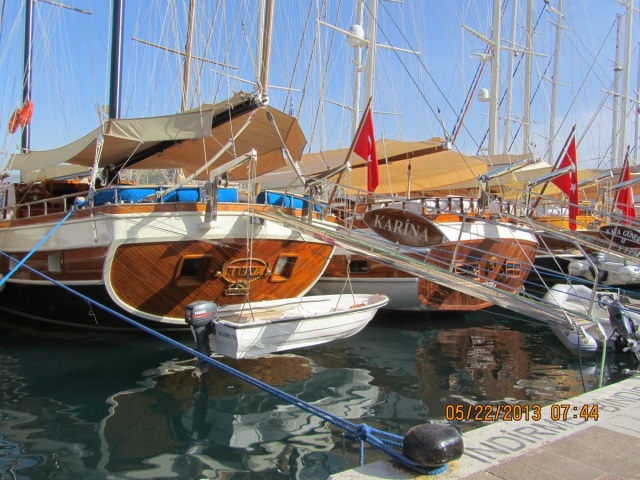 |
||
| Galet Boats in the harbor at Bodrum |
 |
| St. Peter’s Castle, Bodrum, Turkey (from our Galet boat) |
 |
| Chuck snorkels in the chilly water of the Aegean off of our Galet, “Mermaid” |
 |
| Our captain and cook for lunch on “Mermaid” |
 |
| Chuck and Cathy enjoy cocktails aboard the “Mermaid” |
 |
|
| Connie takes a dive into the Aegean from our Galet |
Once back on the Wind Star, Connie and I took advantage of the ship’s recreation facilities and kayaked in the Aegean from the back of the ship. Unfortunately, we had a double kayak, and were intent upon paddling in opposite directions. I only wanted to circle our sister ship, but Connie is a little stronger than I, so . . .
That night on the ship we were entertained by an on-board barbecue and buffet. The entertainment didn’t stop there, though. The staff and crew danced and sang for us, culminating in a riveting performance of YMCA. Why don’t I have any pictures of this!!!!!
Thursday, May 23, 2013
Next stop, Kusadasi, where we were greeted by tour guide, Gulsum (Rose), from Sea Song.
 |
|||||
| Gulsum (Rose) Kusadasi Tour Guide |
We were whisked once again by private transfer to the ancient city of Ephesus, one of the most amazing architectural sites I have ever visited. We all agreed it put the Acropolis in Athens to shame!
Ephesus is one of the greatest ruined cities in the western world. A Greek city was first built in in about 1000 BC and it soon rose to fame as a center for the worship of Cybele, the Anatolian Mother Goddess. The city today was founded in the 4th century BC by Alexander the Great’s successor, Lysimachus. But it was under the Romans that Ephesus became the chief port on the Aegean. Most of the surviving structures date from this period. As the Harbor silted up, the city declined, but played an important role in the spread of Christianity. Two great Councils of the early Church were held here in AD 431 and 449. It is said that the Virgin Mary spent her last days nearby and that St. John the Evangelist came from the island of Patmos to look after her.
Here are a few highlights.
 |
| Kitty takes a break on the ruins at Ephesus (Artistic Inspiration???) |
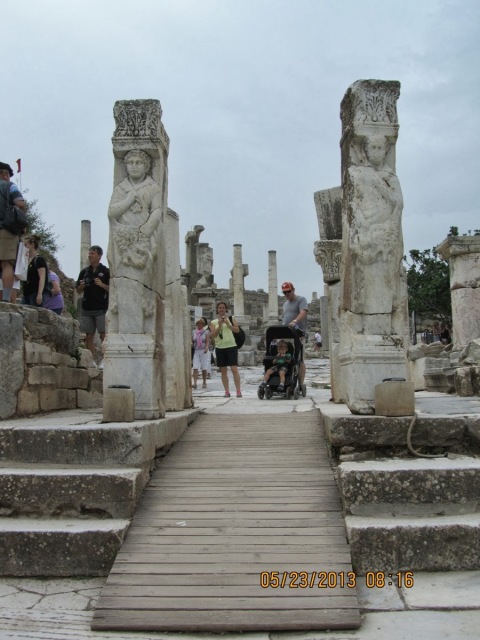 |
| Gates of Hercules, Ephesus, Turkey |
 |
||||
| Mosaic in Terrace House, Ephesus |
The Terrace Houses were amazing, with modern plumbing, heating and cooling. How ignorant I was to believe the people of that era (at least the rich ones) lived modestly!
 |
| Kuretes Street, Ephesus, Turkey |
 |
| Celsus Library, Ephesus, Turkey |
We were told that a secret tunnel from the Celsus Library led to a local brothel, where men could honestly tell their wives, I’ve been “to the library”.
We were also astounded by the public latrines!
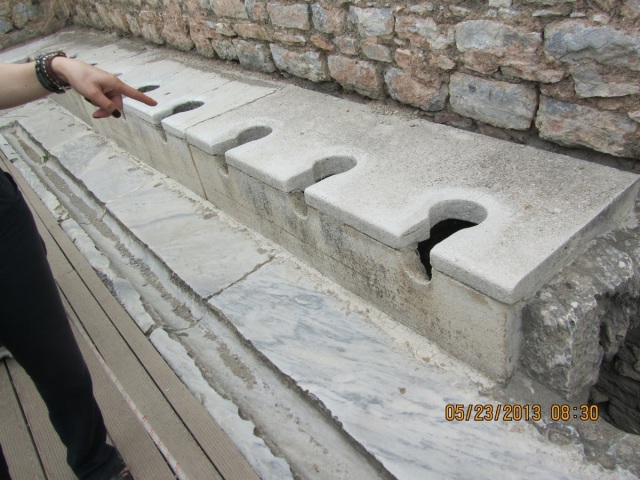 |
| Public Latrine, Ephesus, Turkey |
I can’t say enough about this amazing city! The homes, temples, stadiums, markets–all bespoke of a level of civilization superior in many ways to what we have today! I’d still prefer a little privacy for my latrine, though!
We made our way back to our van, where we were assaulted by vendors trying to sell us “real fake watches” and the like. We resisted temptation and managed to leave unscathed. Our next stop was Elhamra pottery shop, famed for their pristine porcelain ware and their intricately glazed surfaces. We were treated to throwing and glazing demos, followed by a visit to their showroom, where of course, we all succumbed to the temptation and purchased some beautiful, but rather expensive, souvenirs.
 |
| Pottery Demo at Elhambra Pottery, Kusadasi, Turkey |
 |
||||
| Glaze example, before firing |
The next stop was at the ruins of St. John’s Church
 |
| Entrance to ruins of St John’s Church |
 |
| Ruins of St. John’s Church |
Gulsum then took us to the incredibly quaint and beautiful village of Sirince, where we walked to the top of the hilly village to have lunch. The place was very authentic, with the proprietor bringing us course after course, whether we ordered it or not. Gulsum was very firm in refusing items we had not ordered. Of course, we had no idea what we HAD ordered. Once again, cats were everywhere, and they did not hesitate to reach up onto our plates and grab food for themselves! I wonder how the Health Department in the US would feel about that!
 |
| Sirince Village |
 |
| Looking down the pathway at Sirince Village |
 |
| Olives drying outside the entrance to our restaurant |
 |
| Cathy & Chuck at our Sirince Restaurant |
 |
| The local chefs, offering us lunch |
 |
| Our Sirince cook, paddling the flat bread and baking in a wood-burning oven |
Here’s a sampling of what was cooked up for us.
 |
| Sirince Lunch |
Our restaurant was open air, and the view toward the bottom of the hill was astounding. As we ate, we watched this beautiful young bride walking up the hill with her bridal party. We wondered how the young ladies were managing in their high heels!
 |
| Sirince Bride |
 |
| Sirince Shop |
We ended our day some of the picturesque shops in the village. Evil eyes were being sold everywhere, and were embedded in the walkways and other areas of the village. These were there to ward off evil spirits and bad luck. They are generally colored blue, and blue appears to be a “protective color” throughout Anatolia, where you will see doorways painted blue, etc.
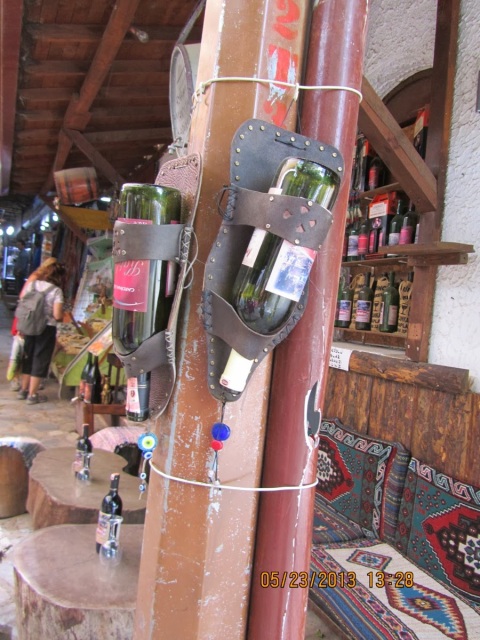 |
| Wine Bottle Holder with Evil Eye attached |
Then it was all aboard our private transfer van, and back to the ship for our final day at sea. Once again, we were spoiled rotten!
Back aboard the Wind Spirit, we enjoyed a quiet evening with dinner and cocktails, and prepared for our day at sea.
Friday, May 24, 2013
In the morning we took in the sights as we sailed through the Sea of Marmara. Of particular interest was the Gallopoli Memorial, the site of the famous battle of Gallopoli in 1915, in which the Allies were unsuccessful, with loss of many lives, both Turkish and Allied.
 |
| Gallopoli Memorial seen from our ship in the Sea of Marmara |
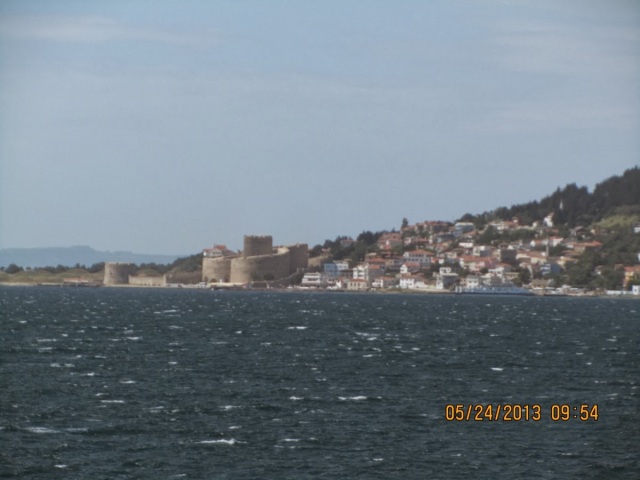 |
| A fortress on the Sea of Marmara |
Once we reached the Dardenelle Straits, a local pilot was required to guide us through the narrow waters. A local pilot was essential on a few other occasions, to guide us through specific areas, and was required by law. These pilots were delivered via small boats like the one pictured below.
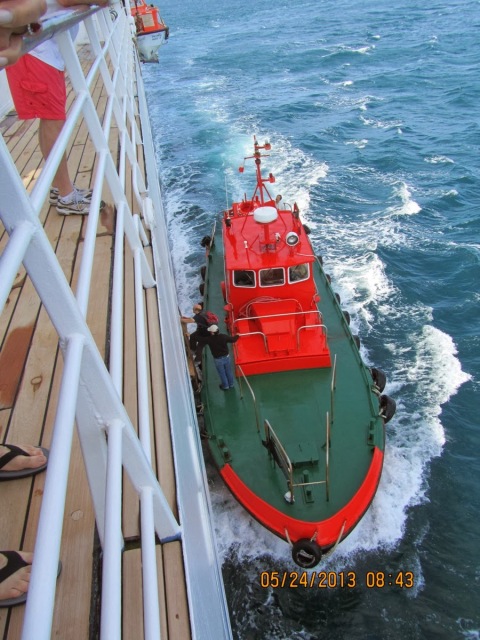 |
| Pilot boarding the Wind Spirit to guide us through the Dardenelles |
On board, we were entertained by the staff and crew. The spa was available and various activities were also planned. We took in a cooking demonstration, emceed by Rob, the Activities Director, as well as a cocktail demonstration by our chief bartender, Ervin.
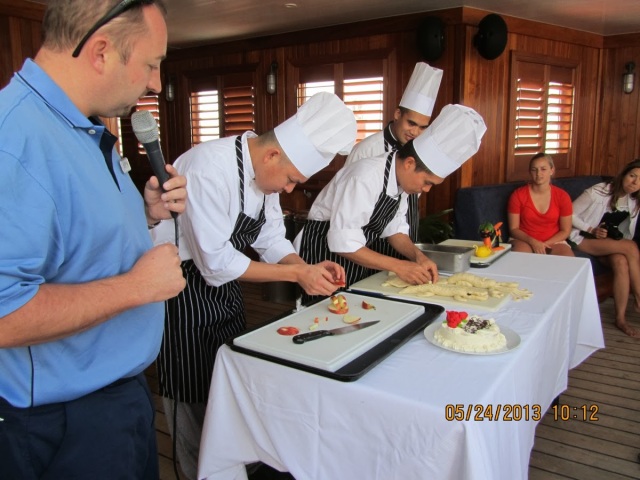 |
| Cooking demo aboard the Wind Spirit |
 |
||
| Ervin gives a Cocktail demo aboard the Wind Spirit |
We also had our photos taken in the bow.
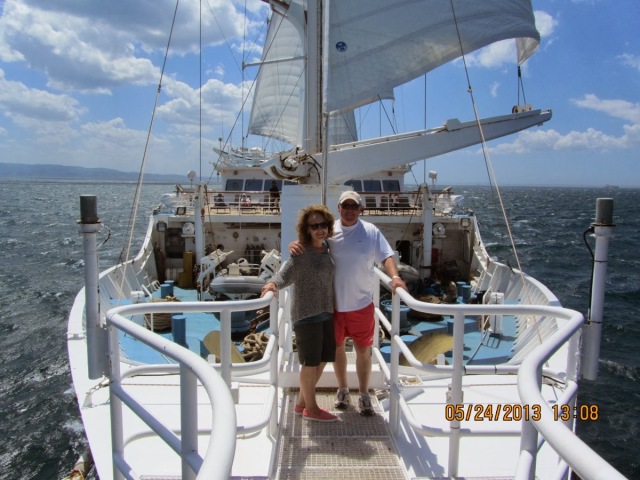 |
| Connie & Deb aboard the Wind Spirit |
We were treated to a tour of the Engine Room by Chief Engineer Rick, who amazed us with how complicated it is to keep a sailing ship running. The winds were in our favor on this trip, and we were under sail power 95% of the time.
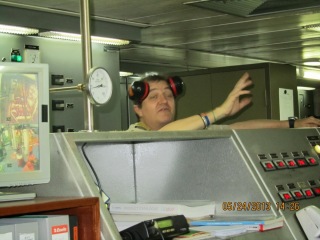 |
| Rick, Head Engineer of the Wind Spirit |
 |
| Wind Spirit Engine Room |
One of the interesting sites from the deck was the area where the City of Troy supposedly once stood and where the Trojan War took place.
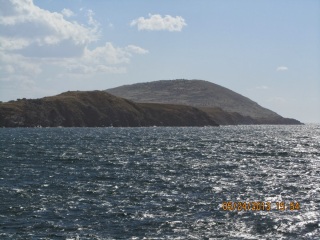 |
| Site of City of Troy |
Chuck continued to entertain us throughout our voyage, and sadly for him, shared some of his adventures with us. In particular, Chuck apparently mistook his cabin door for the bathroom door in the middle of the night, and suddenly found himself out in the hallway in his skivvies! He thought he had locked himself out of his cabin, but was relieved to find he could open the door. He promptly took care of business and went back to bed. Cathy awoke sometime later to discover the door to their cabin was wide open onto the hallway! Huh??
Well of course we had a good laugh about this particular episode, and Connie decided to share it with our Captain, Jeffrey. So the set up began. During our day at sea, as Jeffrey was making the rounds and visiting with the passengers, he approached us as we were enjoying cocktails in our usual spot. Cathy told him what had happened, Jeffrey said he was aware of the situation because Chuck had been caught on camera. Jeffrey informed Chuck that he needed to talk to him about his behavior as he didn’t want to have to ask Chuck to disembark early. We had another good laugh about this, whereupon Jeffrey told us about incidences where he truly HAD to dump passengers for crazy behavior, i.e. running around the decks naked!
Our day at sea included cocktails with some of our new friends, (one a Zimmer rep) and generally a laid back, enjoyable day.
Saturday, May 25
We awoke to a stunning sunrise in the harbor at Istanbul! The sites were breathtaking!
 |
| Istanbul at daybreak from the deck of the Wind Spirit |
Upon disembarking, we collected our luggage and went to wait for our transfer to the airport. That particular area looked a little daunting. A barking dog running wild through the streets and shady-looking characters everywhere made us feel somewhat uncomfortable. But our Sea Song guide stayed with us until the transfer van arrived and we were off the the airport for our flight to Kayseri.
Here’s where my luck ran out as the ticketing agent would not accept my plane ticket. The name on the ticket did not match that on my passport. Cathy’s didn’t either, but that didn’t seem to bother them. Our Wind Song guide explained to me that this was my “un-luchy day”. I set about chasing him all over the airport while trying and get the problem fixed, separated from my friends. I was quickly beginning to think that I would not be going to Cappadocia. I had visions of myself in the huge and scary city of Istanbul all by myself! We ended up having to buy another ticket for me, which the travel agency apparently paid for. I was fortunate that there were seats available–disaster averted! But we were concerned about our return trip, and insisted that return tickets for both myself and Cathy were properly issued. Whew!
The flight thereafter was, thankfully, uneventful. There was some great people watching at the airport, once we arrived in Kayseri. We were fascinated by some of the fashions we saw–this guy in particular.
 |
| Fashion Statement at the airport in Kayseri |
We were transported to Cappadocia, where our guide, Ozgul, took us first to the Fairy Chimneys.
We enjoyed talking with Ozgul, who had special training in tourism. Apparently this is a quite common occupation for young Turks to pursue as tourism is a growing industry there. She pointed out her boyfriend to us, who was leading another tour group in the same area.
Ozgul explained some of the differences between Sunni Muslims and Shiite Muslims. She being Sunni and her boyfriend being Shiite causes problems with their families–especially his. Her family is less strict in their religion. She made us realize that not all Muslims are fundamentalists, and not all are practicing Muslims. Neither she nor any other of our young female guides covered their heads or wore traditional costumes.
When we asked about drinking, we were told that it against the Muslim religion to drink a single drop of alcohol. Therefore, they dip their finger into their alcoholic beverage, remove the first drop, and proceed to enjoy the rest of the libation!
 |
| Ozgul |
Before touring, we had lunch in an outdoor cafe, where the food was prepared in traditional fashion.
 |
| Cook preparing lunch at Fairy Towers |
 |
| Lunch at Fairy Towers in Cappadocia |
After lunch we toured the Fairy Chimneys. Sedimentary rocks, formed by volcanic material between 3 and 9 million years ago were eroded by wind and rain into minaret and pillar forms. From these the people of the region carved distinctive houses, churches and monasteries, some dating back to the Roman Empire. Many were decorated inside with colorful frescoes.
 |
| Fairy Chimneys |
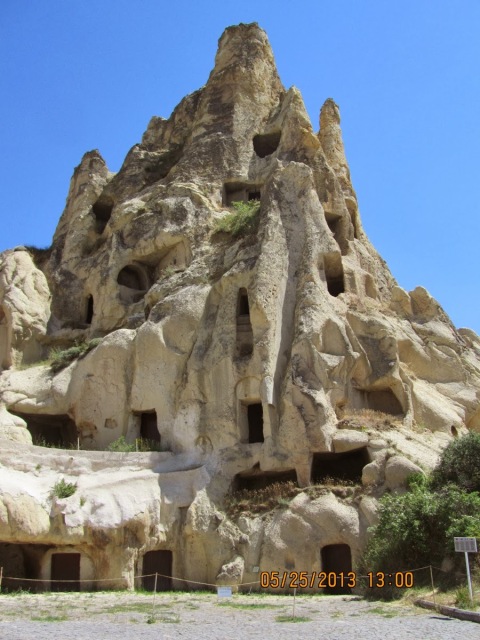 |
| Fairy Chimneys |
We also visited the Goreme Open Air Museum, a former place of worship.
And here’s an example of the frescoes we 
From the Fairy Chimneys, we boarded our van and drove the short distance to Kaymakil Underground City.
Cappadocia is a fascinating journey through times gone by – but ultimately the major attraction to this Central Anatolia moonscape are the underground cities.
Beneath the land of the living, are masses of sprawling tunnels and small cave rooms that are strangely quiet but their history is as the saving grace for civilizations that hid in fear of their lives.
The underground cities of Cappadocia
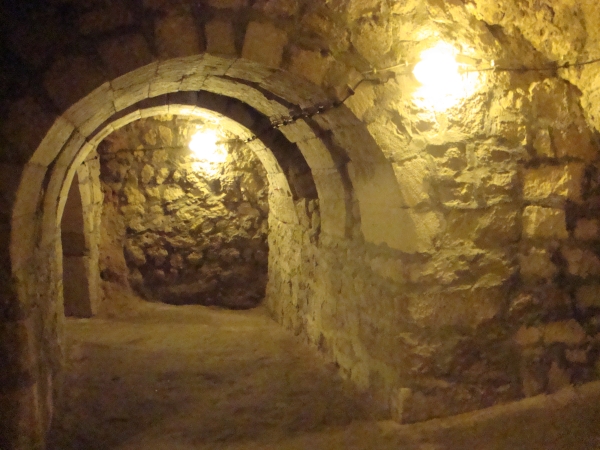
There are about 35 underground cities across the vast landscapes of Cappadocia and they were built with the intention of being hiding places for early Christians who could at any new day, find their way of life under threat from invading forces.
They are wrapped around vast defenses and a massive network of traps, mainly to prevent the advance of the Roman Empire. You’ll be amazed at the technical brilliance of the tribes that once inhabited these vast canyons.
Cappadocia was the confluence of influence. The Hattis, the Hittites, Phrygians, Persians, Romans, Byzantines, Seljuks and Ottomans have all put their own stamp on this area as it was the gateway to such important trade routes, like the illustrious Silk Road.
In doing so, it became a much sought after area, culturally and politically, and hence the need for the many hideouts and cities for civilizations to exist.
At its heart is the village of Göreme where many of its villagers still live in cave dwellings, some of which have been converted into pensions for tourists. Surrounding the area are the amazing rock formations known evocatively as Peri Bacaları or ‘Fairy Chimneys’.
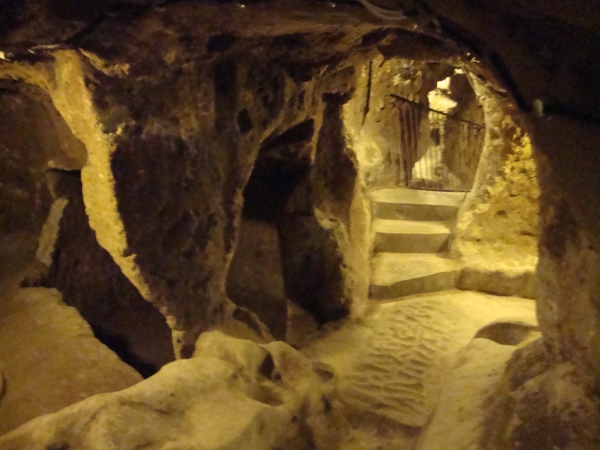
Kaymakli underground city
One of the most famous attractions is the Kaymakli underground city. It consists of 8 floors below ground, only 4 of them which are open to the public.
The first floor of the underground city was used as a stable, while other areas are living quarters and passages into a church.
On the third floor there are storage places and a kitchen, while a block of andesite with relief-texture found on this floor suggests it was used as a melting pot for copper, unearthed from a nearby quarry. It is estimated that the city could have been populated by about 3,000 people.
 |
| Doorway in Kaymakli Underground City |
 |
| Stone Door in Kaymakli Underground City |
 |
| Low ceilings in Kaymakli Underground City |
edimentary rocks, formed from volcanic material between 9 and 3 million years ago, were eroded by wind and rain into minaret and pillar forms. From these the people of the region carved distinctive houses, churches and monasteries, some dating back to the Roman Empire. Many were decorated inside with colorful frescoes.
edimentary rocks, formed from volcanic material between 9 and 3 million years ago, were eroded by wind and rain into minaret and pillar forms. From these the people of the region carved distinctive houses, churches and monasteries, some dating back to the Roman Empire. Many were decorated inside with colorful frescoes.
Sedimentary rocks, formed from volcanic material between 9 and 3 million years ago, were eroded by wind and rain into minaret and pillar forms. From these the people of the region carved distinctive houses, churches and monasteries, some dating back to the Roman Empire. Many were decorated inside with colorful frescoes.
Sedimentary rocks, formed from volcanic material between 9 and 3 million years ago, were eroded by wind and rain into minaret and pillar forms. From these the people of the region carved distinctive houses, churches and monasteries, some dating back to the Roman Empire. Many were decorated inside with colorful frescoes.
Sedimentary rocks, formed from volcanic material between 9 and 3 million years ago, were eroded by wind and rain into minaret and pillar forms. From these the people of the region carved distinctive houses, churches and monasteries, some dating back to the Roman Empire. Many were decorated inside with colorful frescoes.
Sedimentary rocks, formed from volcanic material between 9 and 3 million years ago, were eroded by wind and rain into minaret and pillar forms. From these the people of the region carved distinctive houses, churches and monasteries, some dating back to the Roman Empire. Many were decorated inside with colorful frescoes.
After the tour of Kaymakli, we boarded the van for the trip toward our hotel in Uchisar. On the way, we stopped at Pigeon Valley.
Pigeon valley is situated between Göreme and Uçhisar. The name comes from the thousands of pigeon houses that have been carved into the soft tuff since ancient times. Although they can be found throughout Cappadocia, they are especially numerous in this valley. They were carved wherever space allowed, including abandoned cave houses and churches. In Cappadocia, pigeons have long been a source of food and fertilizer. The advent of chemical fertilizers has reduced the use of pigeon dung. However, some farmers still maintain their lofts because they insist that the reputation of Cappadocian fruits as the sweetest and most succulent in Turkey is entirely due to pigeon dung.
 |
| Pigeons in flight over Pigeon Valley |
We arrived at the Museum Hotel in Uchisar–a hotel literally carved out of stone.
 |
| Museum Hotel, Uchisar, Cappadocia, Turkey |
The grounds were magnificent and our rooms were in caves. We experienced cave dwelling at its absolute finest! Upon arriving we were shown to our rooms, which were both lovely. However, the Britts were short-changed on the bathroom set up and we asked the management for an upgrade. They were, unfortunately, booked for the night, but were gracious and delivered a bottle of wine and some chocolate covered strawberries to our room. Connie was uninterested and went to bed early, but I enjoyed both in the sitting area (aka dance floor) of our room.
 |
| Our room at the Museum Hotel, taken from the “dance floor” |
Here are a few photos of the Museum Hotel Grounds. (I caught Cathy admiring the pool).
 |
| The Museum Hotel Pool and its “amenities” |
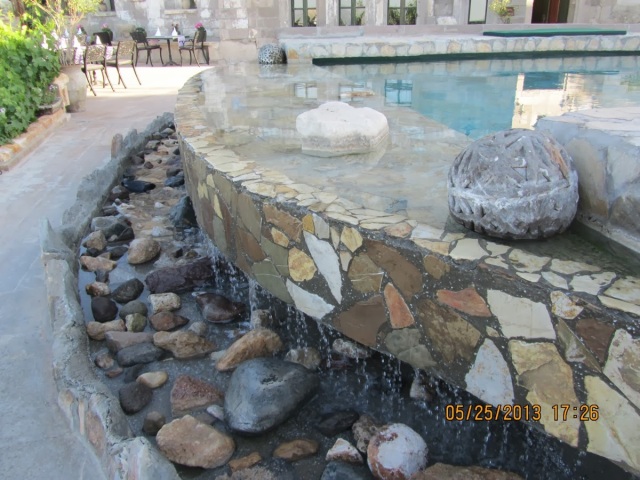 |
| The other end of the pool, complete with waterfall |
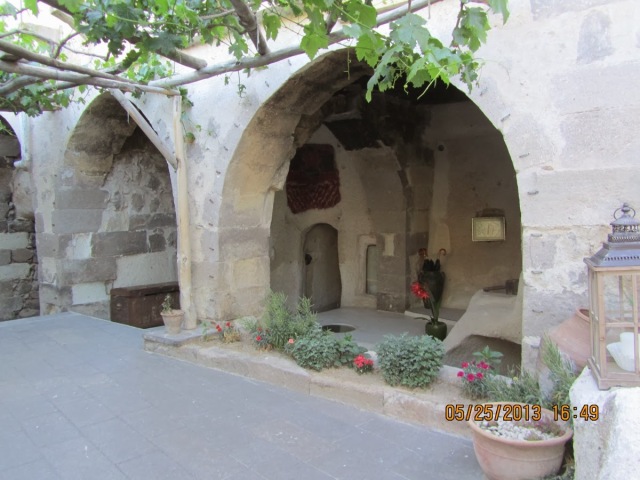 |
| The entrance to our underground rooms |
 |
| The bar area and patio |
 |
| The bar area and patio from below |
This was truly a remarkable hotel. We dined in their dining room, which was quite beautiful. There were many artifacts and museum pieces throughout the hotel, thus the name.
In the morning we were treated to an extensive buffet breakfast, which we enjoyed on their outdoor patio.
Sunday, May 26, 2013
With a little time to kill, I took a little walk through the charming streets of Uchisar, and was able to get photos of Cappadocia Castle. It too, has intricate rooms carved into its slopes
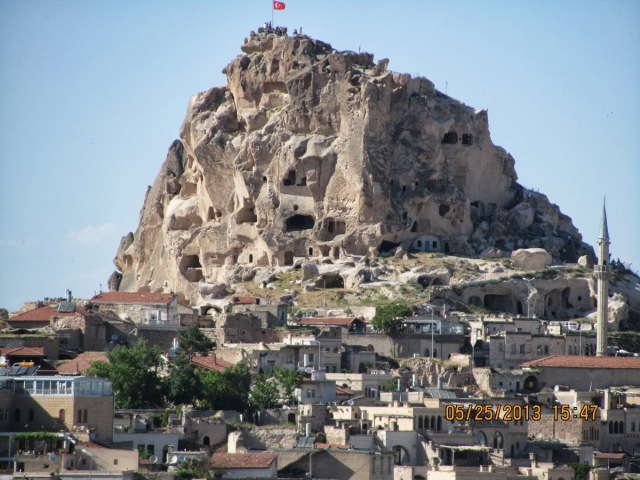 |
||
| Cappadocia Castle |
 |
| Castle at Cappadocia |
One unfortunate note to our Cappadocian adventure. Apparently this area is an amazing place to take a hot air balloon ride, and normally the skies are filled with them. Sadly, a few days before our arrival there was a balloon collision, with fatalities. Three Brazilians were killed and more than 20 others injured. The balloon industry had been shut down to investigate the tragedy.
We were transported by van back to the airport at Kayseri, where we boarded our flight back to Istanbul with no complications.
We were met at the airport by our most wonderful guide, Vedat, a veteran of the guiding profession and a fountain of information.
Vedat took us straight away to the Rustem Pasha Mosque, a Mosque full of beautiful tiles. No shoes are allowed in the Mosques, and ladies must cover their heads. We also noticed men who had come in shorts and were obliged to wrap a skirt around their waists before entering.
 |
| Deb & Cathy don head scarves inside Rustem Pasha Mosque |
 |
| Vedat explaining the history of Rustem Pasha Mosque |
 |
| Lamps adorning Rustem Pasha Mosque |
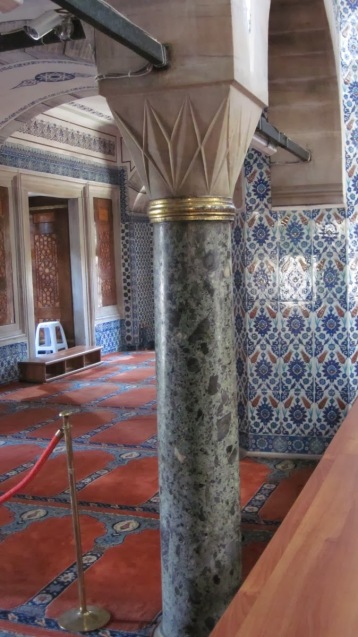 |
| Rustem Pasha Mosque Interior |
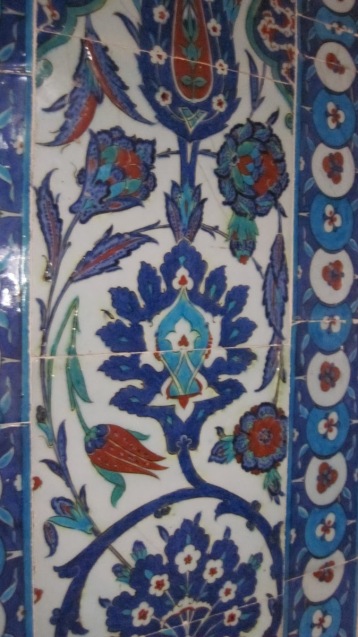 |
| Detail of Tiles in Rustem Pasha Mosque |
The Rüstem Pasha Mosque was designed by Ottoman imperial architect Mimar Sinan for Grand Vizier Damat Rüstem Pasha (husband of one of the daughters of Suleiman the Magnificent, Princess Mihrimah). Rüstem Pasha died in July 1561 and the mosque was built after his death from around 1561 until 1563.[1] The mosque complex hosts now a Koran School.
Architecture
Exterior
The mosque was built on a high terrace over a complex of vaulted shops, whose rents were intended to financially support the mosque complex. Narrow, twisting interior flights of steps in the corners give access to a spacious courtyard. The mosque has a double porch with five domed bays, from which projects a deep and low roof supported by a row of columns.[2]
Interior
The Rüstem Pasha Mosque is famous for its large quantities of exquisite İznik tiles, set in a very wide variety of beautiful floral and geometric designs, which cover not only the façade of the porch but also the mihrab, minbar, walls, columns and on the façade of the porch outside.[3] These tiles exhibit the early use of a tomato-red color that would become characteristic of İznik pottery. Some of the tiles, particularly those in a large panel under the portico to the left main entrance, are decorated with sage green and dark manganese purple that are characteristic of the earlier ‘Damascus ware’ coloring scheme.[4] No other mosque in Istanbul makes such a lavish use of these tiles.[5]
The plan of the building is basically that of an octagon inscribed in a rectangle. The main dome rests on four semi-domes; not on the axes but in the diagonals of the building. The arches of the dome spring from four octagonal pillars— two on the north, two on the south— and from piers projecting from the east and west walls. To the north and south are galleries supported by pillars and by small marble columns between them.[2]
We left the mosque, and Vedat took us to the Egyptian Spice Bazaar, one of the many markets built to support the various mosques. Vedat explained to us that when each Mosque was built, a market or bazaar was built around/beneath it. The rents collected from the vendors helped to support the Mosque. Here we purchased some Saffron to take home.
 |
| Egyptian Spice Bazaar Offerings |
 |
| Vedat and Connie at the Egyptian Spice Bazaar |
 |
| Egyptian Spice Bazaar |
From the Bazaar, Vedat took us to the Underground Roman Basilica Cisterns, and told us tales of putting fish into the cistern as a youth. Apparently a restaurant had originally tried to raise fish there for their use, with no luck. However, there were some carp living there.
 |
| Roman Cistern, Istanbul, Turkey |
 |
| Roman Cistern, Istanbul, Turkey |
Vedat had more stories of guiding film-makers during the making of movies with scenes in the Cistern. It was used in the James bond movie, “From Russia With Love”.
This extraordinary cistern was built by Justinian in 532. Like most sites in İstanbul, the cistern has a colorful history. Known in Byzantium as the Basilica Cistern because it lay underneath the Stoa Basilica, one of the great squares on the first hill, it was used to store water for the Great Palace and surrounding buildings. Eventually closed, it seemed to have been forgotten by the city authorities sometime before the Conquest. Enter scholar Petrus Gyllius, who was researching Byzantine antiquities in 1545 and was told by locals that they could obtain water by lowering buckets in their basement floors. Some were even catching fish this way. Intrigued, Gyllius explored the neighbourhood and discovered a house through whose basement he accessed the cistern. Even after his discovery, the Ottomans (who referred to the cistern as Yerebatan Sarayı) didn’t treat the underground palace with the respect it deserved and it became a dumping ground for all sorts of junk, as well as corpses. It has been restored at least three times.
The cistern is 65m wide and 143m long, and its roof is supported by 336 columns arranged in 12 rows. It once held 80,000 cubic metres of water, pumped and delivered through nearly 20km of aqueducts.
Constructed using columns, capitals and plinths from ruined buildings, the cistern’s symmetry and sheer grandeur of conception are quite extraordinary. Walking on the raised wooden platforms, you’ll feel water dripping from the vaulted ceiling and may catch a glimpse of ghostly carp patrolling the water.
Of special interest were the columns supported by Medusa heads, turned upside down and sideways. Since the columns were constructed of recycled materials it is conjectured that the heads were placed off kilter in disrespect to Medusa, or to ward off her evil intent. Others say since it was reclaimed material, it was just installed in the easiest way possible.
 |
| Medusa Head Column Base in Basilica Cistern |
 |
| Medusa Head Column Base in Basilica Cistern |
We adjourned to our hotel, the Millennium Suites, a charming little boutique hotel within walking distance to many of the major sights of Istanbul. The cobbled street it was on was lined with cafes and small hotels. It was interesting to hear the haunting sound of call the prayers five times a day, including dawn and dusk.
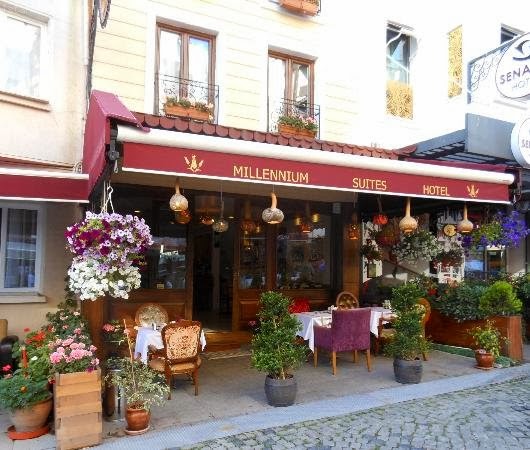 |
| Millennium Suites Hotel, Istanbul |
We were greeted upon arrival by Manager Alper and Taner, who invited us to sit on their patio and enjoy a drink while they transported our luggage to our rooms. We were treated to fresh flowers in our rooms and a complimentary breakfast each morning. We enjoyed talking with Taner, who loved to talk about American films and was a huge fan of Game of Thrones, pointing out that the actress portraying Theiron’s girlfriend is Turkish. He is a student of tourism, and told us he had a rather long commute to get to work at the hotel, but felt he was getting great experience there.
We had dinner our first and last nights in Istanbul in a little restaurant across the street called Magnaura Cafe. Very good, very reasonable Italian fare. We ate upstairs with a view of the street the first night, and a more secluded table on the last.
 |
| Magnaura Cafe, Istanbul, Turkey |
After dinner, Connie and I wandered the streets near our hotel, looking for ice cream. Taner had suggested Mado, which we located near the Blue Mosque and Hagia Sophia. The mosques were quite beautiful at night.
 |
| Hagia Sophia Mosque at night |
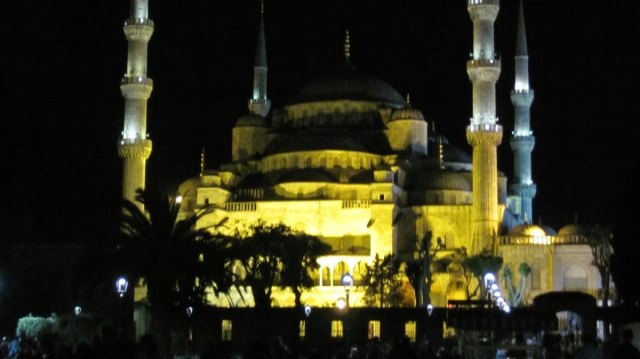 |
| Blue Mosque at Night |
 |
| Connie’s Pistachio Ice Cream from Mado |
Not knowing how to order a single serving, Connie treated himself to an enormous tub of Pistachio Ice Cream, most of what was left in the hotel freezer.
Monday, May 27, 2013
After breakfast the next morning, Cathy and I ventured into a couple of the nearby shops, looking for scarves. We got our scarves, and met some very friendly rug salesmen along the way. Although we had little time, they insisted on serving us Turkish Coffee, an extremely strong concentrated caffeine jolt, to be sure!
We hurried back to the hotel to meet our guide, Vedat and the boys, then set off for the Hippodrome.
Although the Hippodrome is usually associated with Constantinople’s days of glory as an imperial capital, it actually predates that era. The first Hippodrome was built when the city was called Byzantium, and was a provincial town of moderate importance. In AD 203 the Emperor Septimius Severus rebuilt the city and expanded its walls, endowing it with a hippodrome, an arena for chariot races and other entertainment.
In AD 324, the Emperor Constantine the Great decided to move the seat of the government from Rome to Byzantium, which he renamed Nova Roma (New Rome). This name failed to impress and the city soon became known as Constantinople, the City of Constantine. Constantine greatly enlarged the city, and one of his major undertakings was the renovation of the Hippodrome. It is estimated that the Hippodrome of Constantine was about 450 m (1,476 ft) long and 130 m (427 ft) wide. Its stands were capable of holding 100,000 spectators.
The race-track at the Hippodrome was U-shaped, and the Kathisma (emperor’s loge) was located at the eastern end of the track. The Kathisma could be accessed directly from the Great Palace through a passage which only the emperor or other members of the imperial family could use. The Hippodrome Boxes, which had four statues of horses in gilded copper on top, stood at the northern end; and the Sphendone (curved tribune of the U-shaped structure, the lower part of which still survives) stood at the southern end. These four gilded horses, now called the Horses of Saint Mark, whose exact Greek or Roman ancestry has never been determined, were looted during the Fourth Crusade in 1204 and installed on the façade of St Mark’s Basilica in Venice. The track was lined with other bronze statues of famous horses and chariot drivers, none of which survive. The hippodrome was filled with statues of gods, emperors and heroes, among them some famous works, such as a Heracles by Lysippos, Romulus and Remus with their wolf and the Serpent Column of the Plataean tripod.[1] In his book De Ceremoniis (book II,15, 589), the emperor Constantine Porphyrogenitus described the decorations in the hippodrome at the occasion of the visit of Saracen or Arab visitors, mentioning the purple hangings and rare tapestries.[2]
Throughout the Byzantine period, the Hippodrome was the centre of the city’s social life. Huge amounts were bet on chariot races, and initially four teams took part in these races, each one financially sponsored and supported by a different political party (Deme) within the Roman/Byzantine Senate: The Blues (Venetoi), the Greens (Prasinoi), the Reds (Rousioi) and the Whites (Leukoi). The Reds (Rousioi) and the Whites (Leukoi) gradually weakened and were absorbed by the other two major factions (the Blues and Greens).
A total of up to eight chariots (two chariots per team), powered by four horses each, competed on the racing track of the Hippodrome. These races were not simple sporting events, but also provided some of the rare occasions in which the Emperor and the common citizens could come together in a single venue. Political discussions were often made at the Hippodrome, which could be directly accessed by the Emperor through a passage that connected the Kathisma (Emperor’s Loge at the eastern tribune) with the Great Palace of Constantinople.
The rivalry between the Blues and Greens often became mingled with political or religious rivalries, and sometimes riots, which amounted to civil wars that broke out in the city between them. The most severe of these was the Nika riots of 532, in which an estimated 30,000 people were killed[citation needed] and many important buildings, such as the second Hagia Sophia Church, were destroyed. The current (third) Hagia Sophia was built by Justinian following the Nika Revolt.
Constantinople never really recovered from its sack during the Fourth Crusade and even though the Byzantine Empire survived until 1453, by that time, the Hippodrome had fallen into ruin. The Ottoman Turks, who captured the city in 1453 and made it the capital of the Ottoman Empire, were not interested in racing and the Hippodrome was gradually forgotten, although the site was never actually built over.
The Hippodrome was used for various occasions such as the lavish and days-long circumcision ceremony of the sons of Sultan Ahmed III. In Ottoman miniature paintings, the Hippodrome is shown with the seats and monuments still intact. Although the structures do not exist anymore, today’s Sultanahmet Square largely follows the ground plan and dimensions of the now vanished Hippodrome.
Within the Hippodrome, we saw the Serpent Column.
To raise the image of his new capital, Constantine and his successors, especially Theodosius the Great, brought works of art from all over the empire to adorn it. The monuments were set up in the middle of the Hippodrome, the spina. Among these was the Tripod of Plataea, now known as the Serpent Column, cast to celebrate the victory of the Greeks over the Persians during the Persian Wars in the 5th century BC. Constantine ordered the Tripod to be moved from the Temple of Apollo at Delphi, and set in middle of the Hippodrome. The top was adorned with a golden bowl supported by three serpent heads. The bowl was destroyed or stolen during the Fourth Crusade. The serpent heads were destroyed as late as the end of the 17th Century, as many Ottoman miniatures show they were intact in the early centuries following the Turkish conquest of the city.[3] Parts of the heads were recovered and are displayed at the Istanbul Archaeology Museum. All that remains of the Delphi Tripod today is the base, known as the “Serpentine Column”.
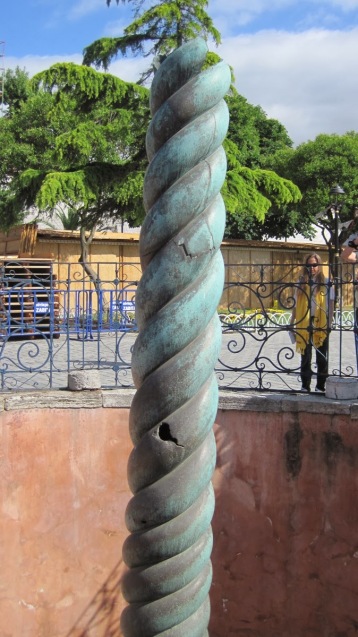 |
| Serpent Column, Hippodrome, Istanbul |
The Egyptian Obelisk, as it stands today, is probably only 1/3 of its original height.
 |
| Egyptian Obelisk, Hippodrome, Istanbul |
Around 1490 BC the Egyptian Pharaoh Thutmose III erected two obelisks before the Karnak temple in Luxor to commemorate the victories of his forces in Mesopotamia. The obelisks were made of rare pink granite.
In the 4th century AD, an unknown Roman emperor who wanted to accomplish something impressive that would create excitement among his people had the colossal obelisk brought to Istanbul, Sultanahmet.
 |
| Egtyptian Obelisk, Istanbul |
For years it was left lying in a corner of the Hippodrome. In 390, during the reign of Theodosius I, it was erected with great difficulty by Proclus, a city administrator. It is the oldest monument in the city and has always been considered magical. The obelisk rests on four bronze blocks on a Roman base decorated with reliefs. These depict the emperor, his children and other prominent personalities watching the races from the imperial box, as well as the spectators, musicians, dancers and chariot races. The obelisk measures 25.60 m including the base.
 |
||
| Constantine’s Tower, Hippodrome, Istanbul |
This column was once covered by metal, which was removed to manufacture ammunition by invading Crusaders.
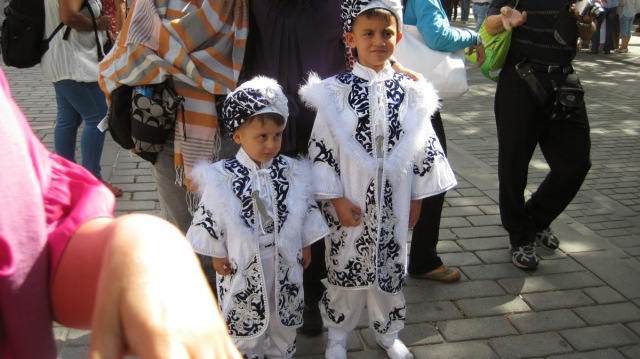 |
|
| Young Turks at the Hippodrome |
We were charmed by these young Turks, all decked out in traditional garb.
Our next stop, again a short walk away, was the Blue Mosque.
 |
| Blue Mosque |
The entrance was interesting in that chains were hung at a height to prevent horses from entering. This was to slow down any invaders who might have had some crazy ideas of overthrowing the Sultan.
 |
||
| Entrance to Blue Mosque |
A quick stop at the Ladies’ Room gave us a glimpse into the floor toilets commonly used in the areas. Perhaps because of traditional clothing for women, it was easier to use a toilet in the floor?
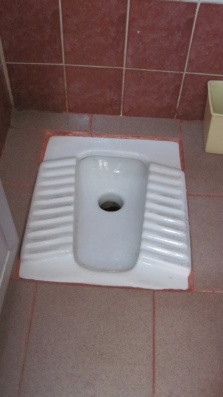 |
| Floor Toilet in Ladies’ Room |
The interior of the Blue Mosque was beautiful. Here’s an interior view.
 |
||
| Blue Mosque Interior |
The Blue Mosque (Called Sultanahmet Camii in Turkish) is an historical mosque in Istanbul. The mosque is known as the Blue Mosque because of blue tiles surrounding the walls of interior design. The Mosque was built between 1609 and 1616, during the rule of Ahmed I. Just like many other mosques, it also comprises a tomb of the founder, a madrasa and a hospice. It is an active mosque, so it is closed to non worshippers for a half hour or so during the five daily prayers.
Worshippers are required to wash their hands and feet prior to praying. Vedat told his this custom was probably adopted in order to reduce the spread of bacteria throughout the area.
The next stop was Topkapi Palace. One of the best descriptions of the Palace can be found here: Topkapi Palace In short, it was the home of many Sultans, with their many wives and concubines, who resided in the harem. The harem was considered to be a family dwelling–not what we have been led to believe is a den of beautiful women, waiting to be chosen for the nightly love fest! There is a rich history, including boy Sultans, imprisoned for many years, only to be released when no other heir to the throne was to be had. Tales of insanity and the murder all of their wives/concubines by chaining them together and throwing them into the sea abound.
 |
| Entrance to Topkapi Palace |
 |
| Harem Room, Topkapi Palace |
 |
| Ceiling of Harem, Topkapi Palace |
The grounds there were beautiful, looking out onto the Bosphorus. Here’s a view of the Rose Garden.
 |
| Rose Garden, Topkapi Palace |
And the view of the Bosphorus from Topkapi.
 |
| View of the Bosphorus from Topkapi Palace |
We also visited the Treasury, where we were treated to the sight of the famous Topkapi Daggar, and the 86 carat Spoonmaker’s Diamond. We were told that upon the birth of each new child in the Sultan’s family, the child was given a box of diamonds measuring 12″ x 12″ x 12″, containing enough wealth to support the child in style for the rest of its life, assuming he/she didn’t squander it.
 |
| Spoonmaker’s Diamond |
 |
||
| Topkapi Daggar |
Upon leaving the palace, I asked Vedat how the Ottomans came by their wealth in the first place. He answered, “First, you have to get an empire . . .” Very funny!
After the staggering beauty of Topkapi Palace, Vedat took us to the Grand Bazaar. The place is enormous–we were lucky to have Vedat with us so that we could skim through and see only the best shops. I purchased a beautiful silk scarf there. The Grand Bazaar is one of the largest and oldest covered markets in the world, with 61 covered streets and over 3,000 shops.
 |
| Grand Bazaar, Istanbul |
Vedat took us to the tiny shop of Nick Merdenyan, who decorates dieffenbachia leaves with calligraphy and gold leaf. Of course we did not resist the temptation, and purchased the leaf pictured below, with the inscription “Tolerance”. It was framed and shipped to us, and is absolutely beautiful! Here’s a link to an article about Nick: The Second Life of Leaves
 |
| Dieffenbachia Leaf, with Islamic symbol for Tolerance |
It was an expensive day for the Britt’s for after the Grand Bazaar, Vedat took us to Orient Handmade Carpets, where we spent a great while shopping for and purchasing two gorgeous Turkish rugs for our home, while sipping Turkish coffee, of course! We also witnessed a short demonstration of the weaving process.
Cathy and Chuck purchased a couple of rugs, but from a different vendor–in fact it was Mustaf, the merchant near our hotel that Cathy and I had met when shopping for scarves a couple of days earlier. When we decided to meet for drinks in a rooftop bar, Mustaf joined us, regaling us with tales of his visits to Cody, WY. He told us that he didn’t do so well selling his rugs there–everyone thought they were overpriced horse blankets! By the time we got out of there–without drinks as the service was lousy–we were pretty sure he was going to try to adopt us!
We had dinner at an enormous Turkish restaurant, with several levels. Taner assured us it was great, and arranged for the restaurant to pick us up at our hotel and return us after dinner. Dinner was good, but maybe not as good as advertised . . .
After dinner we retired to our hotel, where we sat on the patio and enjoyed the company of cats.
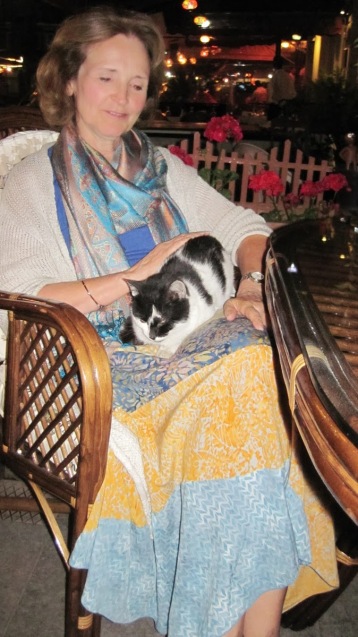 |
| Kitty Love at the Millennium Suites Hotel |
Tuesday, May 28, 2013
After breakfast at the hotel, we were met once again by Vedat. We were picked up by a van, and transported to a pier where we boarded our private boat for a tour of the Bosphorus.
 |
| Our boat on the Bosphorus |
The sites along the Bosphorus were stunning, and included many palaces which had been built by the Sultans for their children.
 |
| Night Club on the shores of the Bosphorus |
 |
| Palace on European side of the Bosphorus |
 |
| Fortress of Europe built in 1452 by Mehmet the Conquerer as his first step in the conquest of Constantinople |
Situated on the narrowest part of the Bosphorus, the fortress controlled a major Byzantine supply route. Mehmet’s Grand Vizier and two other viziers were responsible for building the three towers, and Mehmet, himself, the wall. In the spirit of competition the entire fortress was completed in three months and 20 days.
 |
| House for Sale, $120,000,000 (former residence of Sultan’s daughter) |
 |
| Our Captain and one man crew treated us to snacks during our Bosphorus Tour |
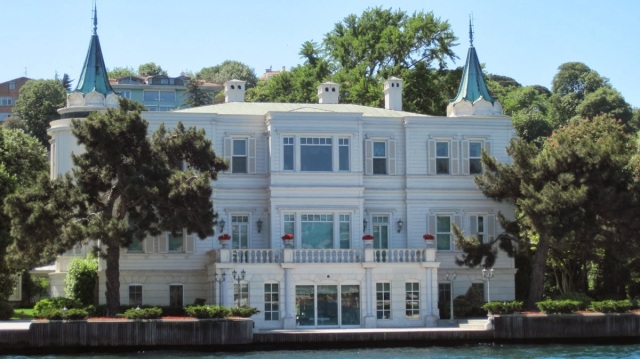 |
| Home on the Asian side of the Bosphorus |
 |
| Chuck Cathy and Vedat taking in the sights from our boat on the Bosphorus |
 |
| Dolmabache Palace (taken from our tour boat on the Bosphorus) |
Other sights included the first bridge to span the European and Asian continents. Istanbul is the only city in the world to span two continents.
 |
| Bosphoros Bridge (first bridge to span the Asian and European Continents |
The boat tour was great fun, and the sights spectacular. My only regret is that we turned around before we made it into the Black Sea! Oh well–next trip!
Vedat then took us to Dolmabache Palace.
Dolmabahçe Palace was ordered by the Empire’s 31st Sultan, Abdülmecid I, and built between the years 1843 and 1856. Hacı Said Ağa was responsible for the construction works, while the project was realized by architects Garabet Balyan, his son Nigoğayos Balyan and Evanis Kalfa (members of the Balyan family of Ottoman court architects.) The construction cost five million Ottoman mecidiye gold coins, 35 tonnes of gold, the equivalent of $1,481,424,175 in today’s (2013) values.[1][2] Fourteen tonnes of gold in the form of gold leaf were used to gild the ceilings of the 45,000 square metre monoblock palace, which stands on an area of 110,000 m².[3][4]
The design contains eclectic elements from the Baroque, Rococo and Neoclassical styles, blended with traditional Ottoman architecture to create a new synthesis. The palace layout and décor reflect the increasing influence of European styles and standards on Ottoman culture and art during the Tanzimat period. Functionally, on the other hand, it retains elements of traditional Ottoman palace life, and also features of traditional Turkish homes. It is the largest palace in Turkey, considering that the area of the monoblock building occupies 45,000 m². Previously, the Sultan and his family had lived at the Topkapı Palace, but as Topkapı was lacking in up-to-date luxury and style, Abdülmecid decided to build the Dolmabahçe Palace near the site of the former Beşiktaş Palace on the Bosporus, which was demolished. Whereas the Topkapı has exquisite examples of Iznik tiles and Ottoman carving, the Dolmabahçe palace contains much gold and crystal. Tourists are free to wander Topkapı at their leisure, while the only way to see the interior of Dolmabahçe is with a guided tour.
Dolmabahçe Palace was home to six Sultans from 1856, when it was first inhabited, up until the abolition of the Caliphate in 1924: The last royal to live here was Caliph Abdülmecid Efendi. A law that went into effect on March 3, 1924 transferred the ownership of the palace to the national heritage of the new Turkish Republic. Mustafa Kemal Atatürk, the founder and first President of the Republic of Turkey, used the palace as a presidential residence during the summers and enacted some of his most important works here. Atatürk spent the last days of his medical treatment in this palace, where he died on November 10, 1938.
The world’s largest Bohemian crystal chandelier is in the Ceremonial Hall (Muayede Salonu). The chandelier, a gift from Queen Victoria, has 750 lamps and weighs 4.5 tonnes. Dolmabahçe has the largest collection of Bohemian and Baccarat crystal chandeliers in the world, and one of the great staircases has balusters of Baccarat crystal.
The site of Dolmabahçe was originally a bay on the Bosporus which was reclaimed gradually during the 18th century to become an imperial garden, much appreciated by the Ottoman sultans; it is from this garden that the name Dolmabahçe (Filled-in Garden) comes from the Turkish dolma meaning “filled” and bahçe meaning “garden.” Various summer palaces were built here during the 18th and 19th centuries.
Ataturk was a revered leader in Turkey. Vedat told us stores of how his grandmother as a little girl was asked by her own grandmother to take some fresh eggs to Ataturk to aid in his recovery from a long-term illness (probably alcoholism). Ataturk received her kindly, but asked her to take the eggs to another member of his cabinet whom he thought was suffering more severely and would benefit more from the gift. He also recounted the tale of how when Ataturk died, his grandmother? stood at the gate to the palace, waiting in line for hour upon hour to pay respects to the leader. The gates collapsed, killing several admirers. She, herself, was spared, and in spite of the tragedy, stayed and continued her vigil to pay respects to the great leader.
 |
| Entrance to Dolmabahce Palace |
 |
|
| Exiting Dalmabahce Palace |
The next stop was Taksim Square, which Vedat pointed out was a popular meeting place in the city. Sadly, a day after we left the area, a riot broke out on that very spot. The public was protesting the development of a park for commercial purposes. The riot caused unrest to break out throughout Turkey, against the government.
 |
| Taksim Square |
This did not stop Connie and Cathy from enjoying their favorite Turkish beer.
 |
| Turkish Beer Sign |
Along the street, called Istiklal Street, we dropped in to a rare Catholic Church, St. Anthony of Padua. Vedat pointed out the irony that one must remove their hat in the Catholic church, but must cover their head in a mosque.
 |
|
| St. Anthony of Padua Church |
We walked up and down Istiklal Street, which is the major, modern commercial street in Istanbul. Vedat offered to stop for snacks, and not understanding we were quite hungry, passed up many mouth-watering cafes along the way.
At last we made our way to the grounds of Hagia Sophia, where before entering, we had lunch at
Old Ottoman House.
 |
| Vedat and Cathy having lunch at Old Ottoman House near Hagia Sophia |
Then on for a tour of the beautiful mosque.
Hagia Sophia Museum (St.Sophia, Ayasofya) was a former Orthodox patriarchal basilica, later a mosque, and now a museum in Istanbul City. From the date of its dedication in 360 until the year of 1453 it served as a Greek Patriarchal cathedral of Constantinople. Following by Ottoman Empire, building turned in to a mosque on 29 May 1453 and remained until 1931 when it was closed to the public for four years. It was re-opened in 1935 as a museum by the Republic of Turkey.
With its massive dome, it is considered the epitome of Byzantine architecture as it is changed the history of architecture. It was also the largest cathedral in the world for almost thousand years until Seville Cathedral built, which was completed in 1520.
The current building was originally constructed as a church between 532 and 537 with the orders of the Byzantine Emperor Justinian. It was the third Church of the Holy Wisdom to occupy the site. The previous two churches had been destroyed by rioters. The Church was designed by the Greek scientists Isidore of Miletus, a physicist, and Anthemius of Tralles, a mathematician. Hagia Sophia contained a large collection of holy relics including a 49 foot (15 m) silver iconostasis. It was the seat of the Patriarch of Constantinople and the religious focal point of the Eastern Orthodox Church for almost one thousand years.
In 1453, Constantinople was conquered by the Ottoman Turks under Sultan Mehmed II. Sultan Mehmed II (Fatih Sultan Mehmed) subsequently ordered the building converted into a mosque. Many items such as bells, altar, iconostasis, and sacrificial vessels were removed and many of the mosaics were plastered over and instead, Islamic features like the mihrab, minbar, and four minarets were added while in the possession of the Ottomans.
As for almost 500 years the principal mosque of Istanbul, Hagia Sophia (St.Sophia, Ayasofya) served as a model for many other Ottoman mosques, such as Blue Mosque, Suleymaniye Mosque and others.
 |
| Hagia Sophia |
 |
| Ceiling of Hagia Sophia |
 |
| Dome of Hagia Sophia |
 |
| Off-center altar–moved to face Mecca when converted to a Mosque |
 |
| Interior of Hagia Sophia |
 |
| Ramp to Second Level of Hagia Sophia |
 |
| Connie and Deb on Balcony of Hagia Sophia |
 |
| Mosaic of Emperor John II Comnenus & Empress Eirene in Hagia Sophia |
Rumor has it that Empress Eirene had this mosaic portrait of her husband changed every time she got a new one (husband, that is). It seems that her husbands met untimely deaths under suspicious circumstances.
Thus ended our time with Vedat, and we reluctantly said goodbye. He was the best of the best, and we loved hearing his tales of all the famous folks he had guided through the years, including Presidents Clinton and Obama. He told us an anecdote about how Obama picked up one of the many stray cats that inhabit the city and was immediately barraged with questions by the Secret Service as to whether or not the cat in question had had its shots!
He also mentioned coming home from guiding to see himself on television with someone, apparently famous, who had made the news for being in Istanbul. Vedat, himself, was unaware who this famous person might have been! To say the least, Vedat was an unusual character, with a vast knowledge of the history of his nation. Having been educated in an English school, his English was impeccable. We grew very fond of him during our short time together.
Wednesday, May 29, 2013
We awoke and prepared for our long journey home. Alper and Taner had arranged an extra early breakfast for us, so we had a few bites before boarding our van to the airport. We received VIP treatment at the airport. We were escorted to a private waiting area with complimentary snacks and drinks before our long flight home.
Upon arrival in the US, we made our way back to the Marriott Airport hotel, and not wanting to break tradition, had a cocktail with Cathy and Chuck before making our way to bed. The next morning we met up with them at Einsteins for a little breakfast and were off. Unfortunately, the Guschewsky’s plane was not ready, but they were able to contact one of their business associates who brought them a car to drive back to Lander. All made it home safely. What a wonderful trip! We all agreed we would do it again in a heartbeat!






